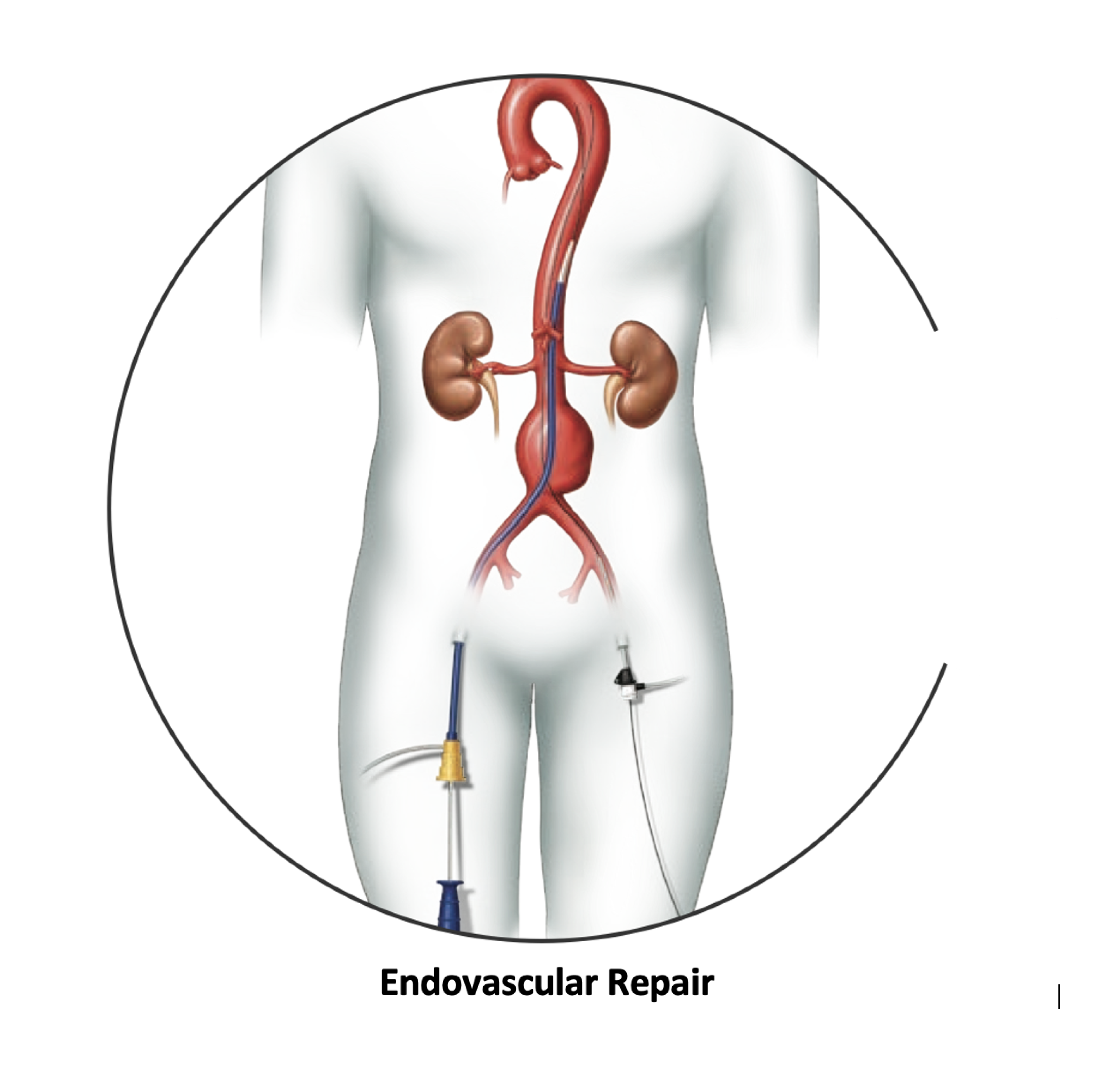Descending Endovascular Aneurysm Repair (EVAR)
EVAR: A Minimally Invasive Option to Treat Aneurysmal Disease

For qualifying patients at risk of aneurysm rupture, the EVAR procedure is a safe and reliable procedure offered by our team at BEVSA. The EVAR procedure is a minimally invasive aneurysm repair option tailored towards older and high surgical risk patients.
Who is Eligible for an EVAR?
The abdominal aorta is a blood vessel responsible for transporting blood to your abdominal organs and legs. Aging and certain risk factors make the abdominal aorta a common spot for aneurysm development. An abdominal aortic aneurysm (AAA) is a bulging or ballooning of the blood vessel which occurs when blood pushes against a weakened or damaged artery wall. If left unmonitored and/or untreated, an AAA may grow large enough to rupture. An AAA rupture is a serious medical emergency causing significant internal bleeding and possibly death.
For patients with an unruptured AAA, your vascular surgeon will assess your aneurysm imaging studies to determine the location and size of your aneurysm. Your vascular surgeon will utilize these findings, as well as your age and comorbidities, to determine the risk of rupture of the aneurysm and if the patient is a suitable candidate for an EVAR. For patients who need to undergo aneurysm repair, our surgeons will use the minimally invasive EVAR option where possible due to its lower procedure time and less risk of complications when compared to the traditional open surgical option.
Procedure Details
The EVAR procedure takes about 2-4 hours at Gates Vascular Institute and most patients are put under general anesthesia.
The procedure begins with two small punctures in both of the patients groins to access the femoral arteries. A delivery catheter (a long tube) is placed through the minimally invasive puncture site and guided up the leg via the femoral artery to the abdominal aneurysm.
Throughout the procedure, the vascular surgeon uses real-time x-ray images and contrast dye injections to visualize the aneurysm, catheter, and endograft without having to make a large incision.
The delivery catheter is then positioned to bring the endograft over the site of the aneurysm. The endograft directs blood through the graft itself and prevents blood from flowing into the aneurysm and potentially causing the aneurysm to rupture.
Next, two iliac limbs are attached to the main body of the endograft. Each iliac limb directs blood from the body of the graft to your leg. This creates a complete endograft system and a new, safer route for blood to flow to your legs without flowing into the aneurysm.
Lastly, your surgeon will inject contrast dye through the endograft system to assess the patients blood flow to ensure proper functioning of the endograft.
Patients, at a minimum, will spend 1 night in the hospital, and most are discharged the following day. For more information about EVAR, and to hear the procedure explained by a member of our team at BEVSA, click on the video below.
Aneurysm Repair Video
Thomas McNamara at BEVSA explains the Endovascular Aortic Aneurysm Repair (EVAR) procedure option for aneurysm treatment and what patients can expect before, during and after surgery.
Frequently Asked Questions
What are the potential benefits and risks associated with endovascular aneurysm repair (EVAR)?
EVAR is a new, minimally invasive treatment option that requires a smaller incision, shorter surgery duration, less risk of surgical complication, and shorter recovery time when compared to open repair. Drawbacks of this procedure are a higher rate of graft complications and possible additional minimally invasive graft repair surgeries when compared to open repair.
Will I feel any different after the procedure?
For symptomatic patients who have abdominal pain, back pain, or gastrointestinal issues related to their growing aneurysm, the procedure can help alleviate symptoms. However, for the majority of patients, the procedure is a preventative measure meant to reduce the risk of patients developing symptoms and possibly aneurysm rupture. Therefore, most patients report being back to their usual activity in a week or two after the procedure.
Do I need to follow up with my vascular surgeon after aneurysm surgery?
After your aneurysm repair, it is critical to follow up with your surgeon so they can examine your incision sites and check to ensure your graft is placed correctly and functioning well. After your first check-up appointment, your physician will likely want to see you every 6-12 months with CT scans or ultrasound studies to measure the size of your aneurysm and ensure it is not growing. Sometimes, if a leak is discovered in the graft, an additional minimally invasive procedure may be necessary to lessen the risk of aneurysm rupture. Patients who fail to follow up with routine appointments are at a heightened risk of aneurysm rupture since we cannot identify and treat any potential problems early on.